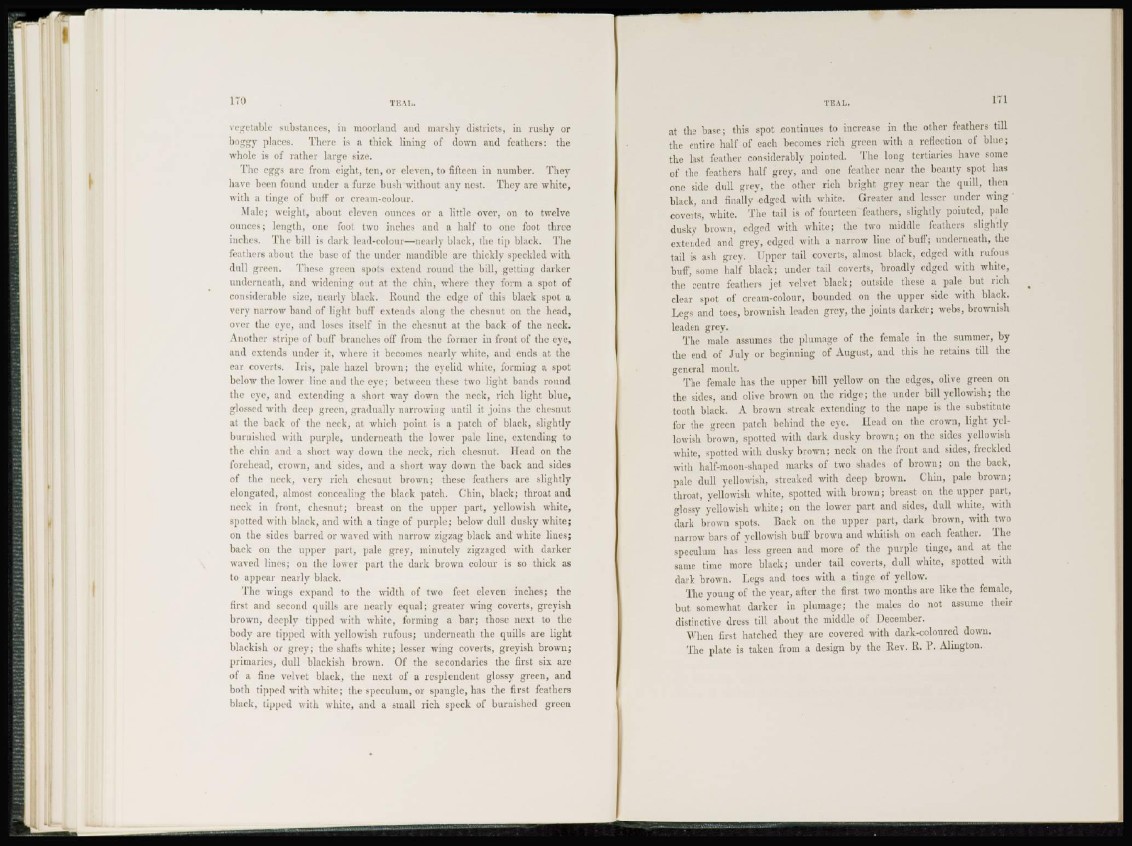
L70
\ egetable substances, in moorland and marshy districts, in rushy or
boggy places. There is a thick lining of down and feathers: the
whole is of rather large size.
The eggs are from eight, ten, or eleven, to fifteen in number. They
have been found under a furze bush without any nest. They are white,
with a tinge of buff or cream-colour.
Male; weight, about eleven ounces or a little over, on to twelve
ounces; length, one foot two inches and a half to one foot three
inches. The bill is dark lead-colour—nearly black, the tip black. The
feathers about the base of the under mandible are thickly speckled with
dull green. These green spots extend round the hill, getting darker
underneath, and widening out at the chin, where they form a spot of
considerable size, nearly black. Eound the edge of this black spot a
very narrow band of light buff extends along the chesnut on the head,
over the eye, and loses itself in the chesnut at the back of the neck.
Another stripe of bull' branches off from the former in front of the eye,
and extends under it, wdiere it becomes nearly white, and ends at the
car coverts. Iris, pale hazel brown; the eyelid white, forming a spot
below the lower line and the eve; between these two light bands round
the eye, and extending a short way down the neck, rich light blue,
glossed with deep green, gradually narrowing until it joins the chesnut
at the back of the neck, at which point is a patch of black, slightly
burnished with purple, underneath the lower pale line, extending to
the chin and a short way down the neck, rich chesnut. Head on the
forehead, crown, and sides, and a short way down the back and sides
of the neck, very rich chesnut brown; these feathers are slightly
elongated, almost concealing the black patch, ('bin, black; throat and
neck in front, chesnut; breast on the upper part, yellowish white,
spotted with black, and with a tinge of purple; below dull dusky white;
on the sides barred or waved with narrow zigzag black and white lines;
back on the upper part, pale grey, minutely zigzaged with darker
waved lines; on the lower part the dark brown colour is so thick as
to appear nearly black.
The wings expand to the width of two feet eleven inches; the
first and second quills are nearly equal; greater wing coverts, greyish
brown, deeply tipped with white, forming a bar; those next to the
body are tipped with yellowish rufous; underneath the quills are light
blackish or grey; the shafts white; lesser wing coverts, greyish brown;
primaries, dull blackish brown. Of the secondaries the first six are
of a fine velvet black, the next of a resplendent glossy green, and
both tipped with white; the speculum, or spangle, has the first feathers
black, tipped with white, and a small rich speck of burnished green
T E A L . 171
at the base; this spot continues to increase in the other feathers till
the entire half of each becomes rich green with a reflection of blue;
t h e last feather considerably pointed. The long tertiaries have some
of the feathers half grey, and one feather near the beauty spot has
one side dull grey, the other rich bright grey near the quill, then
black, and finally -edged with white. Greater and lesser under wing
coverts, white. The tail is of fourteen feathers, slightly pointed, pale
dusky brown, edged with white; the two middle feathers slightly
extended and grey, edged with a narrow line of buff; underneath, the
tail is ash grey. Upper tail coverts, almost, black, edged with rufous
buff, some half black; under tail coverts, broadly edged with white,
the centre feathers jet velvet black; outside these a pale but rich
clear spot of cream-colour, bounded on the upper side with black.
Legs and toes, brownish leaden grey, the joints darker; webs, brownish
leaden grey.
The male assumes the plumage of the female in the summer, by
the end of July or beginning of August, and this he retains till the
general moult.
The female has the upper bill yellow on the edges, olive green on
the sides, and olive brown on the ridge; the under bill yellowish; the
tooth black. A brown streak extending to the nape is the substitute
for the green patch behind the eye. Head on the crown, light yellowish
brown, spotted with dark dusky brown; on the sides yellowish
white, spotted with dusky brown; neck on the front and sides, freckled
with half-moon-shaped marks of two shade's of brown; on the back,
pale dull yellowish, streaked with deep brown. Chin, pale brown;
throat, yellowish white, spotted with brown; breast on the upper part,
glossy yellowish white; on the lower part and sides, dull white, with
dark brown spots. Back on the upper part, dark brown, with two
narrow bars of yellowish buff brown and whitish on each feather. The
speculum has less green and more of the purple tinge, and at the
same time more black; under tail coverts, dull white, spotted with
dark brown. Legs and toes with a tinge of yellow.
The young of the year, after the first two months are like the female,
but somewhat darker in plumage; the males do not assume their
distinctive dress till about the middle of December.
When first hatched they are covered with dark-coloured down.
The plate is taken from a design by the Rev. It. P. Aliugton.